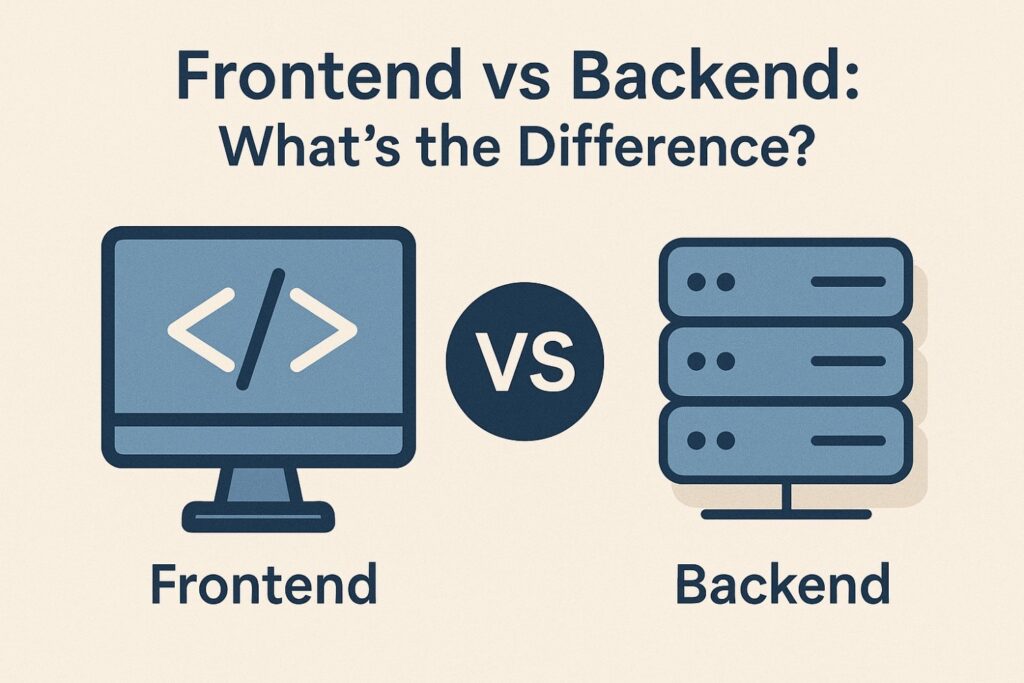Frontend vs Backend: What’s the Difference?
In today’s digital age, having an online presence is essential. Whether you’re building an e-commerce site, a blog, or a full-scale web app, understanding the core concepts of Frontend vs Backend development is crucial. Both are fundamental pillars of web development, yet they serve vastly different purposes. This blog unpacks the key differences between the two and how they work together to create seamless user experiences.
What is Frontend Development?
Frontend development refers to the visual and interactive parts of a website or application—the elements that users directly engage with. This includes layout, design, navigation, fonts, buttons, and anything else you can see or click on in your browser.
Key Technologies Used in Frontend Development
- HTML (HyperText Markup Language): Structures the content on the web.
- CSS (Cascading Style Sheets): Styles the HTML elements with colors, layouts, and fonts.
- JavaScript: Adds dynamic functionality like animations, sliders, and form validations.
- Frontend Frameworks: React, Angular, and Vue.js improve performance and code maintainability.
Skills Required for a Frontend Developer
A good frontend developer should have:
- Strong command of HTML, CSS, and JavaScript
- Experience with responsive design and accessibility
- Familiarity with design tools like Figma or Adobe XD
- Understanding of frontend performance optimization
What is Backend Development?
The backend is the server side of the application. It handles all the logic, database operations, authentication, and data processing that powers the frontend.
Key Technologies Used in Backend Development
- Programming Languages: PHP, Python, Java, Node.js, Ruby
- Databases: MySQL, MongoDB, PostgreSQL
- Servers: Apache, Nginx
- Frameworks: Express.js (Node), Django (Python), Laravel (PHP)
Skills Required for a Backend Developer
Backend developers typically need:
- Proficiency in server-side programming
- Knowledge of database management
- Experience with APIs (REST or GraphQL)
- Understanding of security best practices
Frontend vs Backend: The Core Differences
| Criteria | Frontend | Backend |
| Main Focus | User Interface & Experience | Server Logic & Database Management |
| Tech Stack | HTML, CSS, JavaScript, React, Vue | Python, PHP, Java, Node.js |
| User Interaction | Direct (UI/UX) | Indirect (Data Processing) |
| Security | Basic (form validation, HTTPS) | Advanced (authentication, data encryption) |
| Hosting | Client-Side (Browsers) | Server-Side (Cloud, Dedicated Servers) |
This table gives a clear view of how frontend vs backend responsibilities diverge but are essential for cohesive website development.
Why Both Frontend and Backend Matter
Successful websites or web applications depend on a smooth collaboration between frontend and backend development. For instance:
- The frontend ensures a user can see and interact with a product page.
- The backend retrieves the product details from a database and sends them to the frontend.
If one is weak, the user experience suffers. Imagine a beautifully designed website (frontend) that can’t save form data (backend)—that’s a broken user journey.
When to Choose Frontend, Backend, or Both
Frontend Focus
If you are working on:
- A landing page or portfolio
- UI redesigns or updates
- Creating interactive visual components
Backend Focus
Choose backend development for:
- Managing databases
- Building APIs
- Server-side business logic
Full-Stack Development
Many developers now learn both to become full-stack developers. This allows them to build and manage both the client and server side—ideal for startups or solo developers.
Trends in Frontend vs Backend Development (2025 and Beyond)
Staying updated with website development trends helps developers choose the right tech and stay competitive. Here are some current movements in the frontend and backend worlds:
Frontend Trends
- AI-powered UI personalization
- Component-based design systems
- JAMstack and static site generators like Next.js
Backend Trends
- Serverless architecture
- Cloud-native APIs
- Headless CMS like Strapi or Contentful
These trends are shaping how the next generation of web applications are being built. If you’re starting in web development, these areas are great to explore.
How Frontend and Backend Work Together
Let’s take a quick example: You visit an online bookstore.
- The frontend displays book covers, search bar, and filters.
- When you search “fiction,” a request is sent to the backend.
- The backend queries the database and sends results.
- The frontend then updates the UI to show fiction books.
This seamless interaction is what makes a user-friendly site. The synchronization of frontend vs backend development is at the heart of great digital experiences.
Popular Tools Used in Frontend and Backend
Frontend Tools
- VS Code for coding
- Bootstrap for UI components
- Webpack or Vite for bundling assets
- Sass for better CSS organization
Backend Tools
- Postman for API testing
- Docker for containerization
- Git for version control
- CI/CD Pipelines for automated deployment
Career Paths in Frontend vs Backend Development
Frontend Developer
- Job Titles: UI Developer, Web Designer, Frontend Engineer
- Salary (India): ₹4L to ₹15L per annum
- Focus: UI/UX performance and aesthetics
Backend Developer
- Job Titles: Software Developer, API Developer, Backend Engineer
- Salary (India): ₹5L to ₹20L per annum
- Focus: Server performance, data logic, and security
Tip: Those interested in a balanced role may pursue full-stack development.
Conclusion: Which One Should You Choose?
The answer to frontend vs backend depends on your interests and goals.
- If you enjoy design, user experience, and visual creativity, start with frontend development.
- If problem-solving, logic, and data management excite you, go with backend development.
Both fields are vital for successful web development, and choosing the right path—or mastering both—can lead to a rewarding tech career.
Whether you’re starting your journey or upskilling, understanding the difference between frontend and backend is the first step toward becoming a better developer.
Final Thoughts
Frontend vs Backend isn’t a competition—it’s a partnership. Both disciplines work together to deliver responsive, dynamic, and secure web applications. Embrace both sides to understand how the web works and craft user-first digital solutions.



